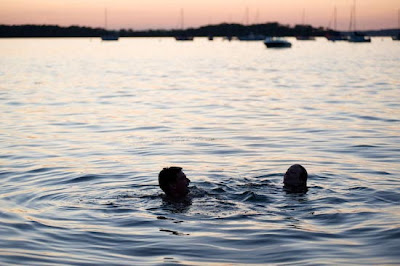Safety on small water
One of the things that we should all take very seriously while sailing is safety. As small lake sailors, we need to make sure that sailing on a small bodies of water does not lull us into complacency. Safety has several aspects. Here are some of my thoughts.
Some of this is easy, because it is mandated by the US Coast guard, or by the MN DNR. This list should be look upon as minimums.
- Life jackets. One approved type 1,2,3,5 for every person on-board. Per MN law, anyone under 10 years of age must wear one while on deck.
- Throw-able. One approved throw ring or seat cushion
- A horn or whistle.
- 1 fire extinguisher
That is just a list of stuff that you need to have on board to be legal. But that does not make you safe. Being a safe and prudent skipper is more about your processes and mindset. Here are some things to think about.
When taking guests out, find out if they can swim. This is so important. If they cannot, insist that they wear a PFD. I'd suggest having one or more lightweight inflatable PFDs on board. Stylish and light, people will not feel awkward wearing them. You can put one on too if you think it might make the person feel better. If you go this route, make sure it is an automatic inflatable, which inflates on contact with the water. A non-swimmer will not have the presence of mind to pull an inflation cord if they end up in the drink. Also note, in many cases these inflatables DO NOT count as part of your on-board PFD total unless they are worn at the time of inspection.
Always get a good local weather forecast. Keep your eye on the advance of bad weather, and listen to the weather radio. Get off if big winds, storms, or tornadoes are warned of. You can see THIS post for more information on weather radios.
Have a cell phone on board, and transport/store it in a waterproof bag. If you have a water emergency, call 911. There is NO ONE monitoring VHF channel 16 for maydays. The 911 operator will likely dispatch the Minneapolis or Hennepin County water patrol.
Make sure you have an anchor on board that can hold your boat in strong winds. The little trolling motors we have to use on lakes Harriet and Calhoun do not have enough power to push into a strong wind. Getting caught on the wrong side of the lake in a storm can be a disaster unless you have a way to hold yourself off the shore.
MOB. Make sure you crew knows what to do in a Man Over Board situation, and most importantly, what to do if it is you, the skipper, that has fallen out. The throw ring is nice, but can't bring a person back to the boat. If you typically sail with your partner, make sure that you both can solo the boat back to a MOB person, or at LEAST quickly stall the boat into irons to let the person get back, or get to the thrown item. I suggest having a throw-bag on board. This unit, which can be hung from the stern rail, cost $15 dollars and can be thrown 50 feet. A good idea on any lake. You can see them HERE
Soloing. If you are out by yourself, be sure to wear your PFD, and carry your cell phone in a waterproof sea-bag. If you fall out, typically someone will see you, but do you want to take that chance?
Think ahead, be prepared. This is the best advice of all. Make if part your sailing. If plays into one of the best sailing definitions I have ever heard:
The true definition of 'excellent seamanship' is the combination of good planning and judgment that saves a skipper from having to exhibit excellent seamanship.
Truer word never spoken.





Comments
Post a Comment